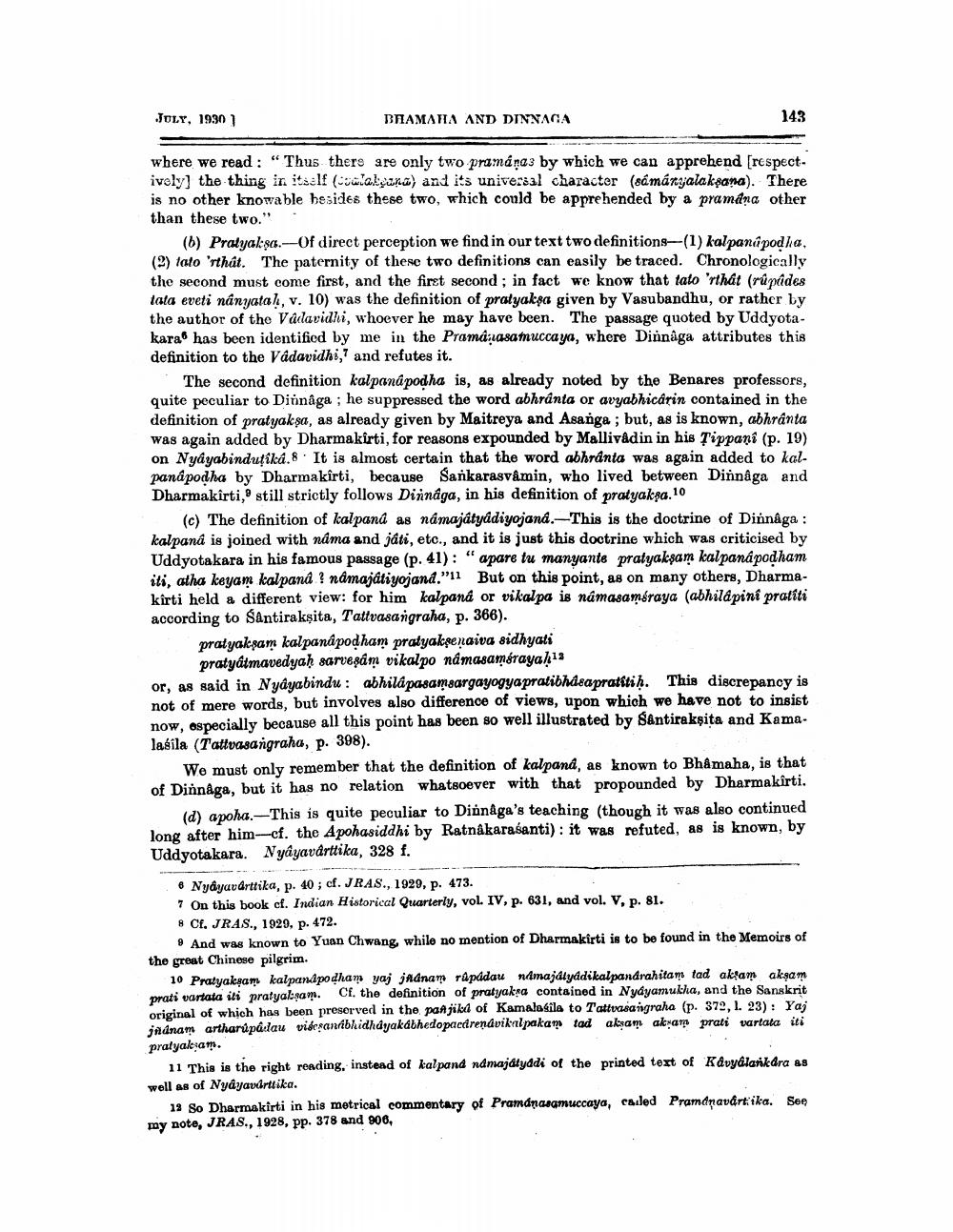________________
JULY, 1930
BAAMAHA AND DINNAGA
143
where we read: “Thus there are only two pranána3 by which we can apprehend [respect. ively] the thing in itself (volalguna) and its universal character (sámányalaksana). There is no other knowable besides these two, which could be apprehended by a pramana other than these two."
(6) Pratyaksa.--Of direct perception we find in our text two definitions--(1) kalpaná podla. (2) tato 'rthat. The paternity of these two definitions can easily be traced. Chronologically the second must come first, and the first second ; in fact we know that tato 'rthát (rúpades tata eveti nányatal, v. 10) was the definition of pratyaksa given by Vasubandhu, or rather by the author of the Vallavidhi, whoever he may have been. The passage quoted by Uddyotakara has been identified by me in the Pramálasamuccaya, where Dinnåga attributes this definition to the Vådavidhi, and refutes it.
The second definition kalpaná podha is, as already noted by the Benares professors, quite peculiar to Dirnåga; he suppressed the word abhránta or avyabhicárin contained in the definition of pratyaksa, as already given by Maitreya and Asanga ; but, as is known, abhránta was again added by Dharmakirti, for reasons expounded by Mallivadin in his Tippani (p. 19) on Nyâyabindutika.8. It is almost certain that the word abhránta was again added to kalpanapodha by Dharmakîrti, because Sankarasvåmin, who lived between Dinnâga and Dharmakirti, still strictly follows Dinnaga, in his definition of pratyaksa.10
(c) The definition of kalpaná as námajátyádiyojana. This is the doctrine of Dinnaga : kalpana is joined with nama and játi, etc., and it is just this doctrine which was criticised by Uddyotakara in his famous passage (p. 41): "apare tu manyante pratyaksam kalpaná podham iti, atha keyam kalpana ? námajátiyojand."11 But on this point, as on many others, Dharmakirti held a different view: for him kalpaná or vikalpa is namasambraya (abhilapini pratiti according to Santirakṣita, Tattvasangraha, p. 366).
pratyakşam kalpaná pod ham pratyakgenaiva sidhyati
pratyátmavedyaḥ sarverám vikalpo ndmasambraya 13 or, as said in Nyâyabindu : abhila pasamsargayogyapratibhdsapratitih. This discrepancy is not of mere words, but involves also difference of views, upon which we have not to insist now, ospecially because all this point has been so well illustrated by Santirakṣita and Kamalasila (Tattvasangraha, p. 398).
We must only remember that the definition of kalpand, as known to Bhåmaha, is that of Dinnaga, but it has no relation whatsoever with that propounded by Dharmakirti.
(d) avoha. This is quite peculiar to Dirnåga's teaching (though it was also continued long after him-cf. the Apohasiddhi by Ratnakaraśanti): it was refuted, as is known, by Uddyotakara. Nyâyavárttika, 328 f.
6 Nydyavdrttika, p. 40; cf. JRAS., 1929, p. 473. 7 On this book of Indian Historical Quarterly, vol. IV, p. 631, and vol. V, p. 81. 8 Cf. JRAS., 1929, p. 472.
9 And was known to Yuan Chwang, while no mention of Dharmakirti is to be found in the Memoirs of the great Chinese pilgrim.
10 Pratyaknam kalpandpodham yaj jadnam rûpddau ndmajdlyddikalpandrahitam tad akram aksam prati vartata iti pratyalışar. C. the definition of pratyakra contained in Nydyamukha, and the Sanskrit original of which has been preserved in the panjiki of Kamalasila to Tattvasangraha (p. 379, L. 23): Yaj jndnam artharúpadlau viderantbhidhayakábhedopacarenávikalpakam tad akşam akam prati vartata iti pratyale am.
11 This is the right reading, instead of kalpand ndmajátyddi of the printed text of Kavyalankara as well as of Nyâyavirttika.
12 So Dharmakirti in his metrical commentary of Pramanasamuccaya, caded Pramaravarti ika. See my note, JRAS., 1928, pp. 378 and 906,




